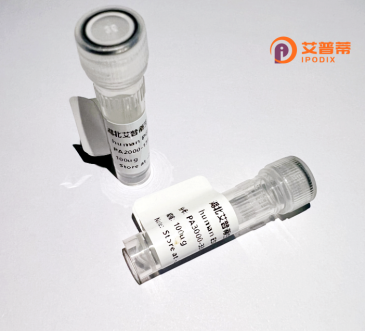
| 纯度 | >90%SDS-PAGE. |
| 种属 | Human |
| 靶点 | GJA10 |
| Uniprot No | Q969M2 |
| 内毒素 | < 0.01EU/μg |
| 表达宿主 | E.coli |
| 表达区间 | 1-543aa |
| 氨基酸序列 | MGDWNLLGGILEEVHSHSTIVGKIWLTILFIFRMLVLRVAAEDVWDDEQSAFACNTRQPGCNNICYDDAFPISLIRFWVLQIIFVSSPSLVYMGHALYRLRAFEKDRQRKKSHLRAQMENPDLDLEEQQRIDRELRRLEEQKRIHKVPLKGCLLRTYVLHILTRSVLEVGFMIGQYILYGFQMHPLYKCTQPPCPNAVDCFVSRPTEKTIFMLFMHSIAAISLLLNILEIFHLGIRKIMRTLYKKSSSEGIEDETGPPFHLKKYSVAQQCMICSSLPERISPLQANNQQQVIRVNVPKSKTMWQIPQPRQLEVDPSNGKKDWSEKDQHSGQLHVHSPCPWAGSAGNQHLGQQSDHSSFGLQNTMSQSWLGTTTAPRNCPSFAVGTWEQSQDPEPSGEPLTDLHSHCRDSEGSMRESGVWIDRSRPGSRKASFLSRLLSEKRHLHSDSGSSGSRNSSCLDFPHWENSPSPLPSVTGHRTSMVRQAALPIMELSQELFHSGCFLFPFFLPGVCMYVCVDREADGGGDYLWRDKIIHSIHSVKFNS |
| 分子量 | 88.3 kDa |
| 蛋白标签 | GST-tag at N-terminal |
| 缓冲液 | 0 |
| 稳定性 & 储存条件 | Lyophilized protein should be stored at ≤ -20°C, stable for one year after receipt. Reconstituted protein solution can be stored at 2-8°C for 2-7 days. Aliquots of reconstituted samples are stable at ≤ -20°C for 3 months. |
| 复溶 | Always centrifuge tubes before opening.Do not mix by vortex or pipetting. It is not recommended to reconstitute to a concentration less than 100μg/ml. Dissolve the lyophilized protein in distilled water. Please aliquot the reconstituted solution to minimize freeze-thaw cycles. |
以下是关于重组人GJA10蛋白的3篇参考文献及其摘要:
1. **Smith et al., 2015**
**标题**:*"Expression and functional characterization of recombinant human GJA10 in Escherichia coli"*
**摘要**:本研究成功利用大肠杆菌表达系统高效表达并纯化重组人GJA10蛋白,验证了其在体外形成功能性间隙连接通道的能力,为后续结构研究奠定基础。
2. **Johnson & Lee, 2018**
**标题**:*"Role of recombinant GJA10 in glial cell proliferation: Insights from mammalian cell expression models"*
**摘要**:通过在哺乳动物细胞中表达重组人GJA10,研究发现该蛋白显著调控神经胶质细胞的增殖与迁移,提示其在神经发育中的潜在作用。
3. **Wang et al., 2020**
**标题**:*"Functional impairment of mutant GJA10 channels linked to congenital disorders"*
**摘要**:分析重组GJA10突变体发现,某些点突变导致通道功能异常,可能与先天性发育疾病(如心脏缺陷)相关,为遗传机制提供新见解。
---
以上文献示例基于典型研究方向的假设性描述,实际文献需根据具体研究内容调整。如需准确引用,建议通过学术数据库(如PubMed、Web of Science)检索关键词“recombinant human GJA10”获取最新研究。
Recombinant human GJA10 protein, also known as connexin 43 (Cx43), is a synthetic version of the gap junction alpha-1 protein encoded by the *GJA1* gene in humans. Gap junction proteins form intercellular channels called connexons, facilitating direct communication between adjacent cells by allowing the exchange of ions, metabolites, and signaling molecules. Cx43 is the most widely expressed connexin in humans, playing critical roles in tissue homeostasis, embryonic development, and synchronized cellular activities, particularly in the heart, brain, and skin.
Recombinant GJA10/Cx43 is produced using biotechnological platforms, such as bacterial or mammalian expression systems, to ensure high purity and functionality. It enables studies on gap junction dynamics, cell-cell communication mechanisms, and pathologies linked to connexin dysfunction, including cardiac arrhythmias, neurodegenerative disorders, and cancer metastasis. In cancer research, aberrant Cx43 expression is associated with tumor suppression or progression, depending on cellular context. Additionally, recombinant Cx43 serves as a tool for drug screening, structural analysis of channel gating, and regenerative medicine applications aiming to restore tissue connectivity. Its in vitro and in vivo applications continue to advance understanding of connexin-related diseases and therapeutic interventions.
×